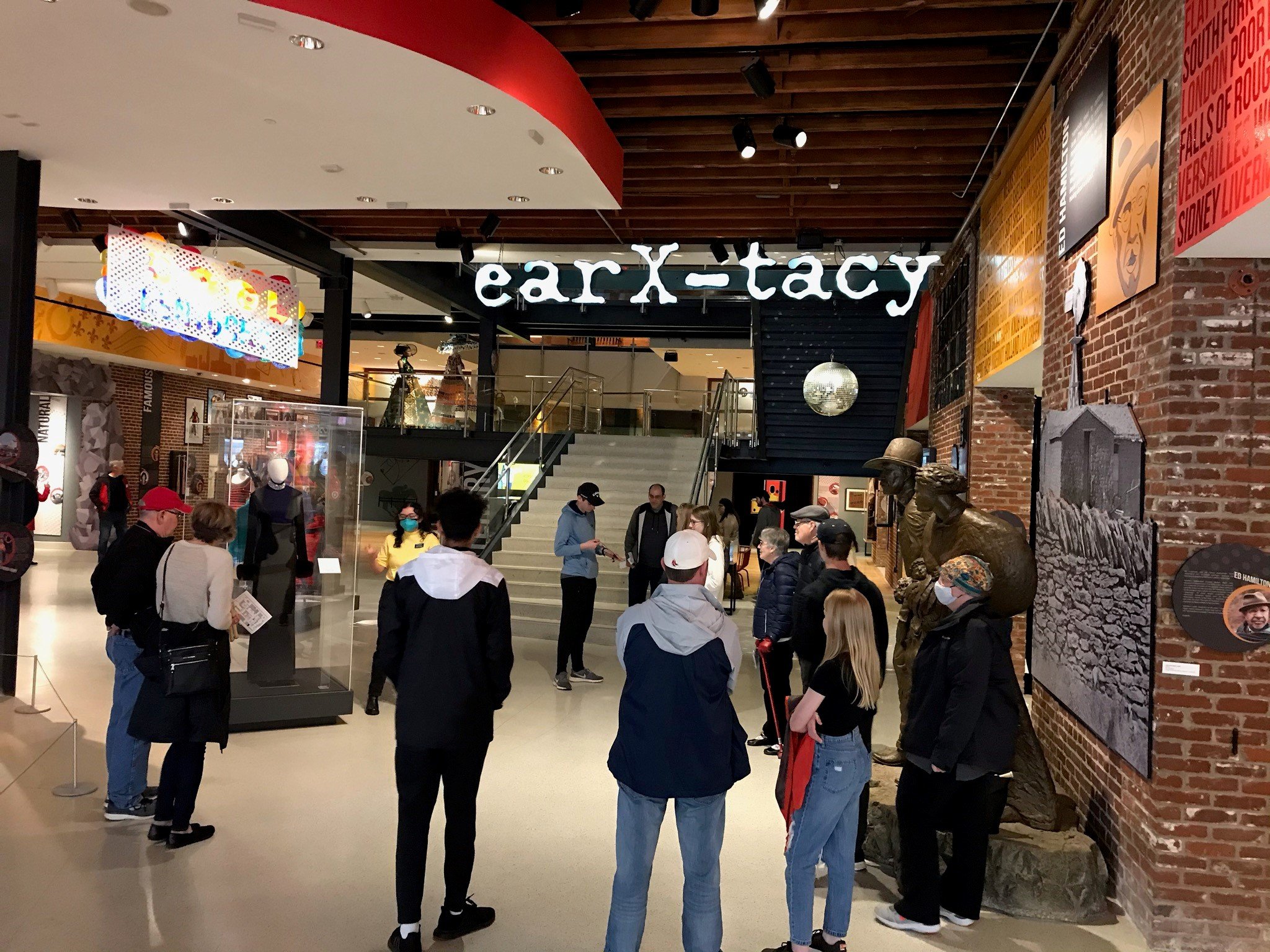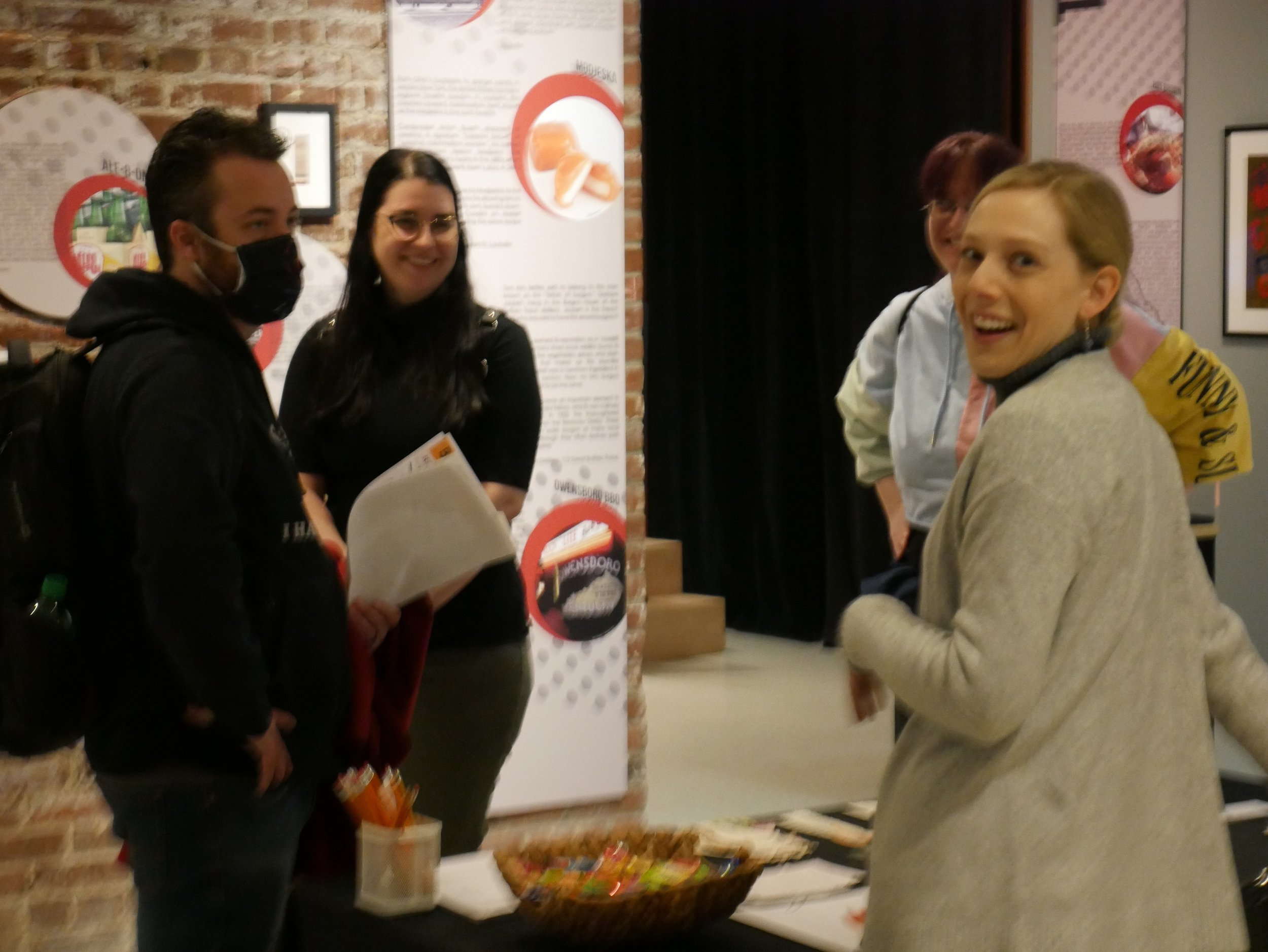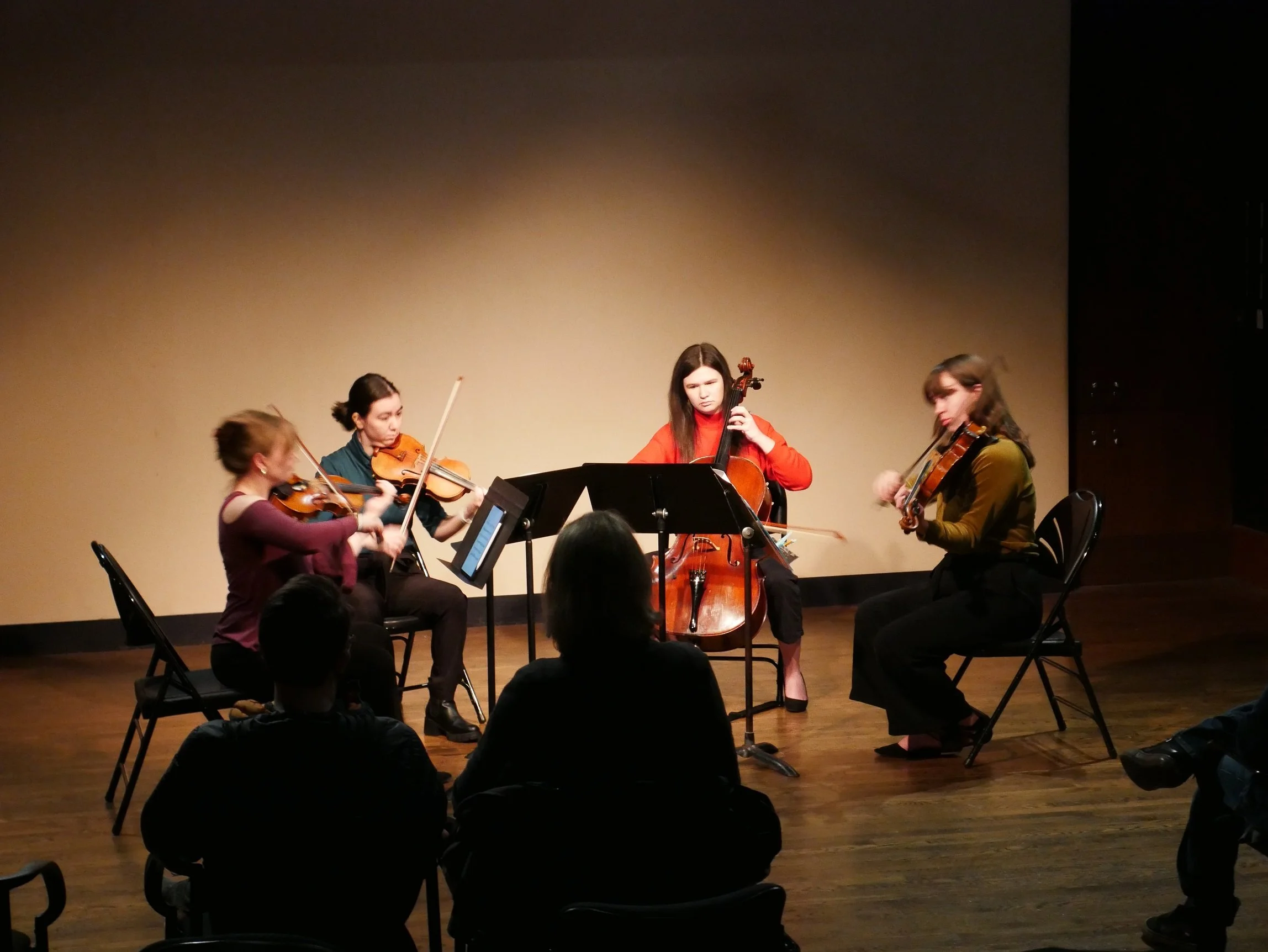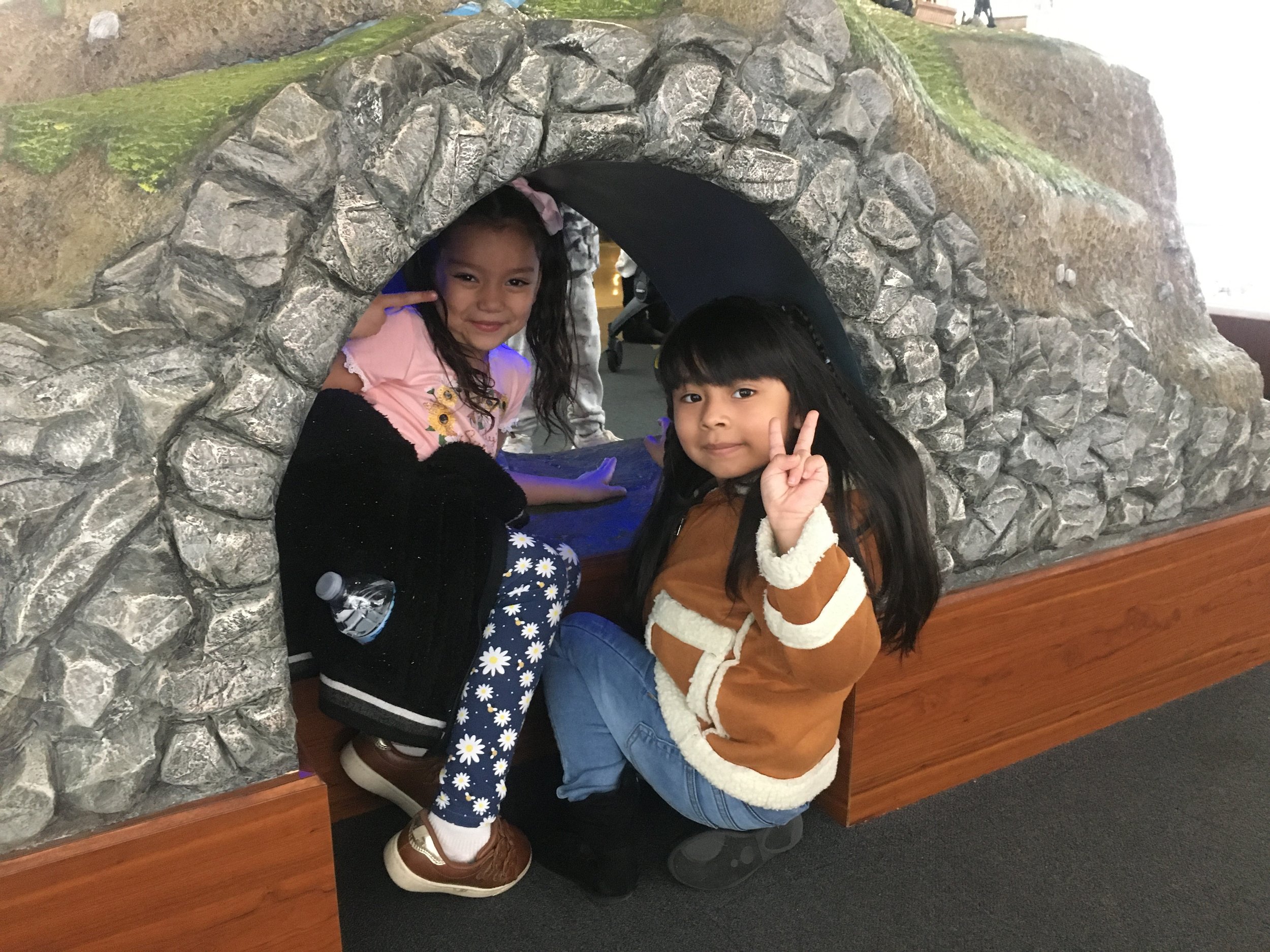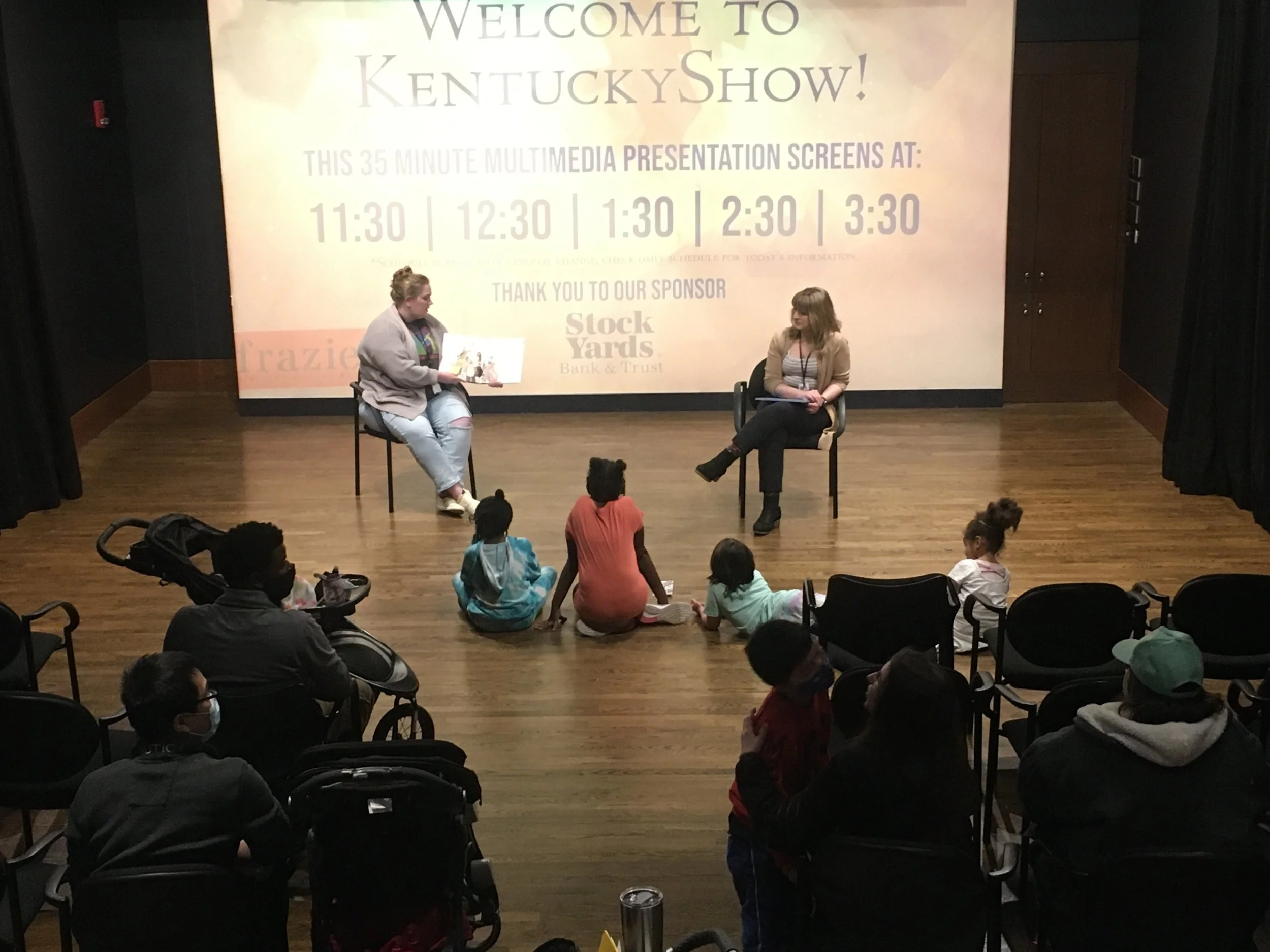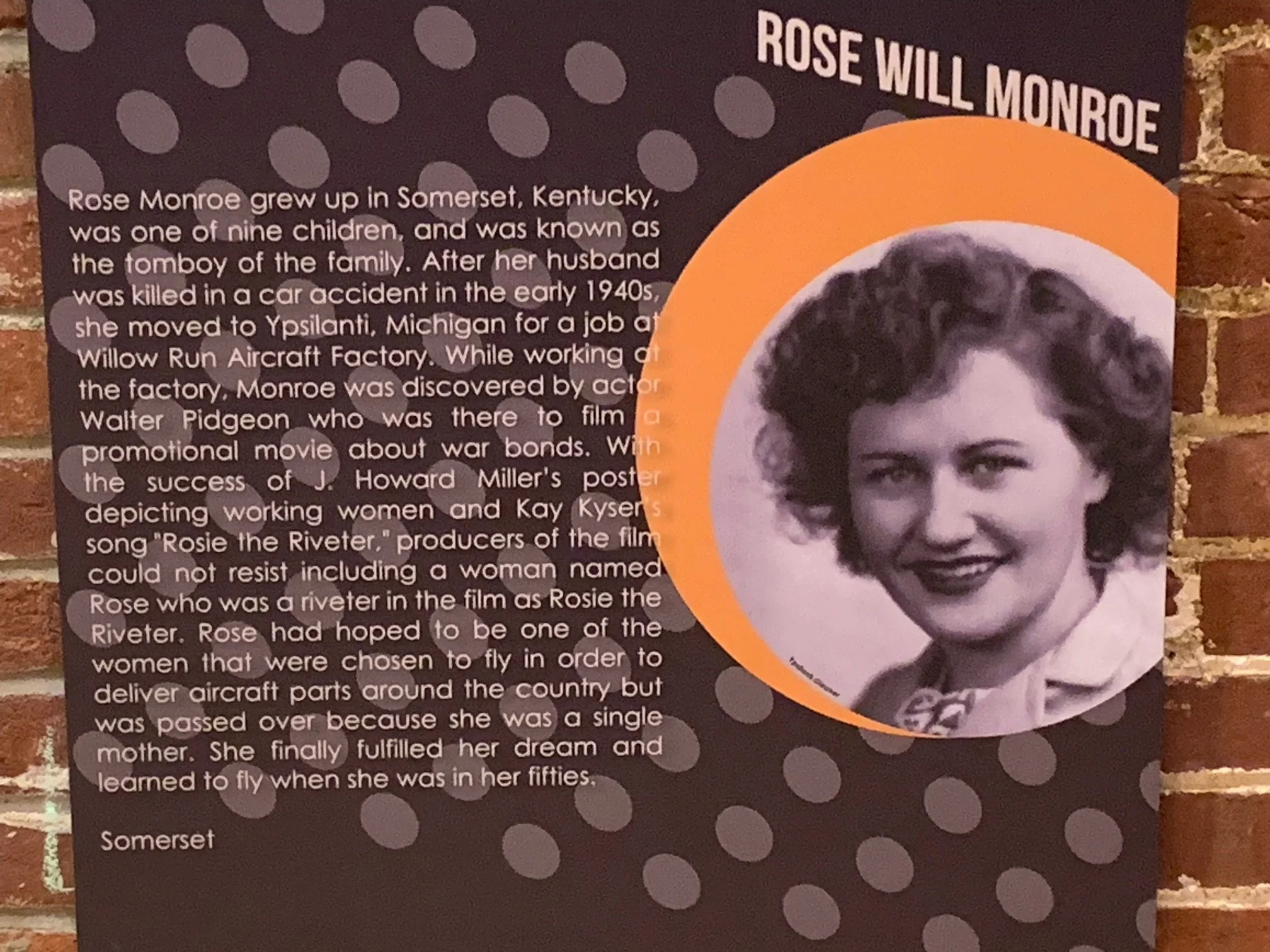Parkland’s “Black Six,” Countdown to “The Commonwealth” Exhibition Opening, Spring Break in LA (Louisville Area), and More
Have you heard of the Black Six?
It’s one of many stories highlighted in our West of Ninth: Race, Reckoning, and Reconciliation exhibition—but one I didn’t know, and wanted to learn more about.
On Tuesday, May 24, from 6 to 7 p.m., you can attend our “Bridging the Divide” program “The Black Six.” The Frazier Museum is partnering with Lean Into Louisville and the Courier Journal to take a closer look at the case, and how some of the same issues continue to play out in Louisville fifty-four years later.
The Black Six Trial by Mary Cobb, undated. The subjects depicted are, from left, Walter T. “Pete” Cosby, Manfred G. Reid, Ruth Bryant, Robert Kuyu Sims, Samuel Hawkins, and James Cortez. Part of the Mary B. Cobb Collection at the Filson Historical Society. Credit: Filson Historical Society.
In May 1968, a white Louisville police officer pulled over Black schoolteacher Charles Thomas, reportedly because he was driving a car similar to one used in a crime. Thomas’s friend Manfred Reid saw the traffic stop unfold and intervened, asking questions about the arrest. Crowds gathered, additional officers were called in, and police got into an altercation with Thomas and Reid, who were arrested. Those charges were later dropped.
One of the police officers was terminated for using excessive force; but he was later reinstated, by which point outrage had already begun to grow.
A meeting takes place outside Moon Cleaners and Laundry, located at 1032 South Twenty-eighth Street, at the southwest corner of Twenty-eighth and Greenwood, in Parkland, May 27, 1968. In the distance, two men standing on a car address the crowd: Sam Hawkins, head of the Black Unity League of Kentucky, wearing a dark shirt, and James Cortez. Both would later be charged, along with the other four members of the “Black Six.” Credit: Robert Steinau, Courier Journal.
National Guardsmen stand with rifles ready in front of looted stores on the east side of Twenty-eighth Street between Dumesnil and Virginia in Parkland, May 28, 1968. Credit: Robert Steinau, Courier Journal.
The series of events led to what civil rights activist Anne Braden called the “Louisville Rebellion.” The epicenter of the rebellion was the intersection of Twenty-eighth and Greenwood Streets in the Parkland neighborhood. There were several days of confrontations with police and the National Guard, two boys were killed, and hundreds of residents were arrested.
Defense attorneys and several of the defendants dubbed the “Black Six” face Jefferson Criminal Court Judge Herman G. Jorris during a pre-trial conference, January 17, 1969. Credit: Jon Webb, Courier Journal.
In the wake of those riots, five Black men and one woman were dubbed “the Black Six.” They were each arrested on conspiracy charges related to the rioting.
For two years, they were prosecuted. But the case was eventually dismissed.
On May 24, we will talk with some of the members of the Black Six, including Reid, as well as family members and one of the defendants’ attorneys, here at the Frazier.
Learn the names of these six individuals, what happened, the personal toll it took, and how those events have parallels to present-day Louisville.
The story ties back to the original quote we know so well: “Those who cannot remember the past are condemned to repeat it.”
Let’s learn about the past together. We hope you will join us.
Also in today’s Frazier Weekly, Hayley Rankin counts down to the opening of our new permanent exhibition on the Commonwealth, Stephen Yates invites you to a free Mint Julep event courtesy of Louisville Tourism in Sippin’ With Stephen, Andy Treinen shows you why the Frazier was the place to be for spring break, and Simon Meiners offers a bird’s-eye view of the 800 block of West Main Street, where on August 6 the second annual Summer Beer Fest at Frazier will take place. Plus, Rosie the Riveter and the Tuskegee Airmen make their mark.
Rachel Platt
Director of Community Engagement
Frazier History Museum
This Week in the Museum
Countdown to The Commonwealth: Women’s Relief Corps National Convention Ribbon, 1895
Logo for The Commonwealth: Divided We Fall. Credit: Frazier History Museum.
Each week leading up to the May 20 opening of the Frazier History Museum’s next permanent exhibition “The Commonwealth: Divided We Fall,” manager of collection impact Hayley Rankin will highlight an object or objects to be included in the exhibition. This week’s installment marks five weeks out!
Opening May 20, 2022, “The Commonwealth” will tell the story of Kentucky’s rich history, including, among other topics, its native peoples, the Civil War, and the early nineteenth century, when cities such as Louisville gained prominence due to their important locations along the Ohio River. It will expand viewers’ personal connection to history by pairing historic figures like Henry Clay, emancipationist Cassius Clay, and Abraham Lincoln with diverse narratives from lesser-known figures in Kentucky history.
In partnership with artist Ché Rhodes and the (Un)Known Project, led by artist-run nonprofit IDEAS xLab, the exhibition will include a space for visitors to reflect on the stories, both known and unknown, of the enslaved that lived in Kentucky. This interactive exhibition is designed to engage visitors of all ages and will feature objects related to Kentucky’s diverse history as a border state on the banks of the Ohio, including the clock face from the top of the Town Clock Church in New Albany, Indiana, an important stop on the Underground Railroad, and the Bloedner Monument, the oldest surviving memorial to the Civil War.
“The Commonwealth: Divided We Fall” has been made possible in part by a major grant from the National Endowment for the Humanities.—Amanda Briede, Curator
Ribbon from the Women’s Relief Corps Thirteenth National Convention held in Louisville, Kentucky, 1895. Credit: Frazier History Museum.
We are extremely excited about The Commonwealth and how it will share known and unknown stories of both prominent and everyday Kentuckians who’ve made our state what it is today. To begin our countdown from five, I’ve selected a ribbon from the Women’s Relief Corps Thirteenth National Convention that occurred here in Louisville in 1895.
The Women’s Relief Corps was the only legally recognized auxiliary organization to the Grand Army of the Republic, a fraternal organization for Civil War veterans. While the G.A.R. ceased to exist in 1956, the Women’s Relief Corps remains active today to help veterans and preserve the history of the organization. The Kentucky Department of the WRC was established in 1886 with Mary Lyle Reynolds as their first President. She would later become Chaplain for the WRC at the national level. When the Grand Army of the Republic held their twenty-ninth National Encampment in Louisville in 1895, the Women’s Relief Corps met simultaneously in Library Hall on Fourth Street. Though this ribbon belonged to a member from Maine, it represents the time Kentucky welcomed women from nearly every state to promote national unity and increase their charitable work throughout the nation.
Hayley Rankin
Manager of Collection Impact
As the official starting point of the Kentucky Bourbon Trail®, the Frazier History Museum shares stories of the people, places, and producers of the Kentucky Bourbon industry. To learn more, visit our Kentucky Bourbon Trail® Welcome Center or tour our Spirit of Kentucky® exhibition.—Simon Meiners, Communications & Research Specialist
This episode of Sippin’ With Stephen puts the focus on Kentucky Derby entertaining via both a dessert and cocktail idea. My guests are both from Louisville Tourism: vice president of marketing communications Stacey Yates and marketing communications manager Jessica Dillree, the resident mixologist. In addition to being coworkers in the marketing department at Louisville Tourism, these two women host Bourbon and Biscuits, a wildly popular YouTube show I encourage you to check out.
Today, Stacey will show me how to make a Mint Julep Kiss and Jessica will show everyone how to make a Mint Julep Sparkler. As folks are looking for items to serve for their own Derby party, this delicious treat and cocktail will help make your shindig a smash! Also, don’t forget to stop by the Louisville Tourism Visitors’ Center at Fourth and Jefferson Streets, Friday, April 15, 11:30 a.m.–3:30 p.m., to participate in their FREE Mint Julep event.
Recipe for Mint Julep Kisses
2 egg whites
1/2 cup sugar
1 drop green food coloring
1 drop crème de menthe extract (or peppermint)
6 oz. mini chocolate chips
Whip egg whites into stiff meringue. Slowly add sugar, then food coloring and extract. Fold in chips. Pipe “chocolate kiss” shape swirls out of a pastry bag onto foil-lined cookie sheet. Put into a pre-heated 325 degree oven. Immediately turn off oven and let sit overnight. Makes 2 dozen.
Recipe for Mint Julep Sparkler
1 oz. Bourbon
1/2 oz. crème de menthe
Juice from quarter of a lemon
Prosecco
Fresh mint leaves
Shake Bourbon, crème de menthe, and lemon juice in a cocktail shaker with ice. Strain into a champagne flute. Top with Prosecco. “Spank” the mint between your hands and garnish your cocktail with it.
Stephen Yates
Community & Corporate Sales Manager
Spring Break in LA (Louisville Area) at the Frazier
One of my favorite things to do this time of year is walk downstairs to talk to guests in the exhibitions and the museum store. It’s wonderful learning where our visitors call home and how they found the Frazier during their travels. Attendance at the museum and foot traffic up and down Main Street have been outstanding, making it abundantly clear to everyone other than Mother Nature that spring has sprung!
Shelby Durbin, yellow shirt, leads a tour of Cool Kentucky, March 30, 2022. Credit: Frazier History Museum.
Simon Meiners, red shirt, discusses the impact of director Tod Browning’s 1931 horror film Dracula while leading a tour of Cool Kentucky, April 1, 2022. Credit: Frazier History Museum.
Bring on the hats, horses, and hordes of national and international travelers who choose Louisville, Kentucky, above all others, as the place to be on the first Saturday of May. Next week, many of us celebrate Easter Sunday—and Kentucky Derby Festival events are now underway, including BourbonVille here at the Frazier. There really is no better place than Derby City to experience the promise of spring!
Teaching artist Brian West performs in Give Us the Ballot!, playwright Larry Muhammad’s one-act play about Louisvillian Russell P. Lee and his 1961 bid to be elected to the nearly all-white Board of Aldermen, April 9, 2022. Credit: Frazier History Museum.
Guest services associate Candy Roberts leads a tasting as part of a Ready, Set, Go! Bourbon Experience in the Frazier’s Order of the Writ, April 9, 2022. Credit: Frazier History Museum.
Manager of collection impact Hayley Rankin speaks with visitors on Family Day, April 9, 2022. Credit: Frazier History Museum.
Thanks to all of you who took a brief break from the bustling responsibilities of school and work to spend a few hours enjoying the Frazier. It is my hope that each and every one of you received a warm welcome and an interesting engagement with one of our hardworking team members. Our goal is to mean more to more people every day, so it brings me great joy to know we did that with thousands of people this spring break.
Quartet Diocia performs in the Frazier’s Brown-Forman Theatre on Family Day, April 9, 2022. Credit: Frazier History Museum.
Visitors play in the Frazier’s Stewart Historic Miniatures Gallery on Family Day, April 9, 2022. Credit: Frazier History Museum.
Visitors attend a story time reading in the Frazier’s Brown-Forman Theatre on Family Day, April 9, 2022. Credit: Frazier History Museum.
The culmination for local families who spent spring break in “LA” (a.k.a. the Louisville Area) was without question Saturday’s free event “Family Day: Barrier Breakers.” With music from string ensemble Quartet Dioica, who performed pieces by women composers Florence Price and Jessie Montgomery; snacks from Poppin’ Flavors Gourmet Popcorn for the kiddos, and activities all day celebrating barrier-breaking Kentuckians, it was a hoppin’ day here at 829 West Main!
If you haven’t visited in a while, come see us.
Andy Treinen
President & CEO
Teen Volunteers Needed for 2022 Frazier Summer Camps
If you’re looking for the most fun way to get your volunteer hours in town, look no further than the Frazier’s summer camps! We are seeking to fill a few teen volunteer openings this summer.
Education intern Hannah and campers show off their Mothman crafts during a cryptid-themed lesson, 2021. Credit: Frazier History Museum.
This is a fun role that our campers look forward to taking on once they’ve graduated from camps. Whether you’ve participated in a Frazier camp or not, we welcome responsible and mature middle and high school students ages thirteen to seventeen.
Summer campers show off their membership badges for the “Scrunchie Club” at the Frazier, 2019. Credit: Frazier History Museum.
Your day will consist of: helping get supplies together for camp, helping kids warm up by facilitating games and activities in the morning and afternoon, taking the campers out for bathroom and water breaks as needed, helping in the galleries for small-group activities, assisting with crafts, and helping us with transitions from classrooms, other areas in the museum, and possibly outside sites. If we are able to take off-site visits to places within walking distance, you may also be assigned to chaperone a small group of campers within a contained area.
Interested in learning more? Email us at education@fraziermuseum.org to get started.
Heather Gotlib
Manager of Youth & Family Programs
Drone Photos of 2022 Summer Beer Fest at Frazier Location
On Saturday, August 6, the Frazier will host 2022 Summer Beer Fest at Frazier—the museum’s second annual beer festival. While last year’s event took place at Ninth and Washington Streets, this year’s will have a new location: the entire 800 block of West Main Street, right in front of the museum!
On March 14, photographer Jesse Hurt captured some overhead images of the new location using a drone.
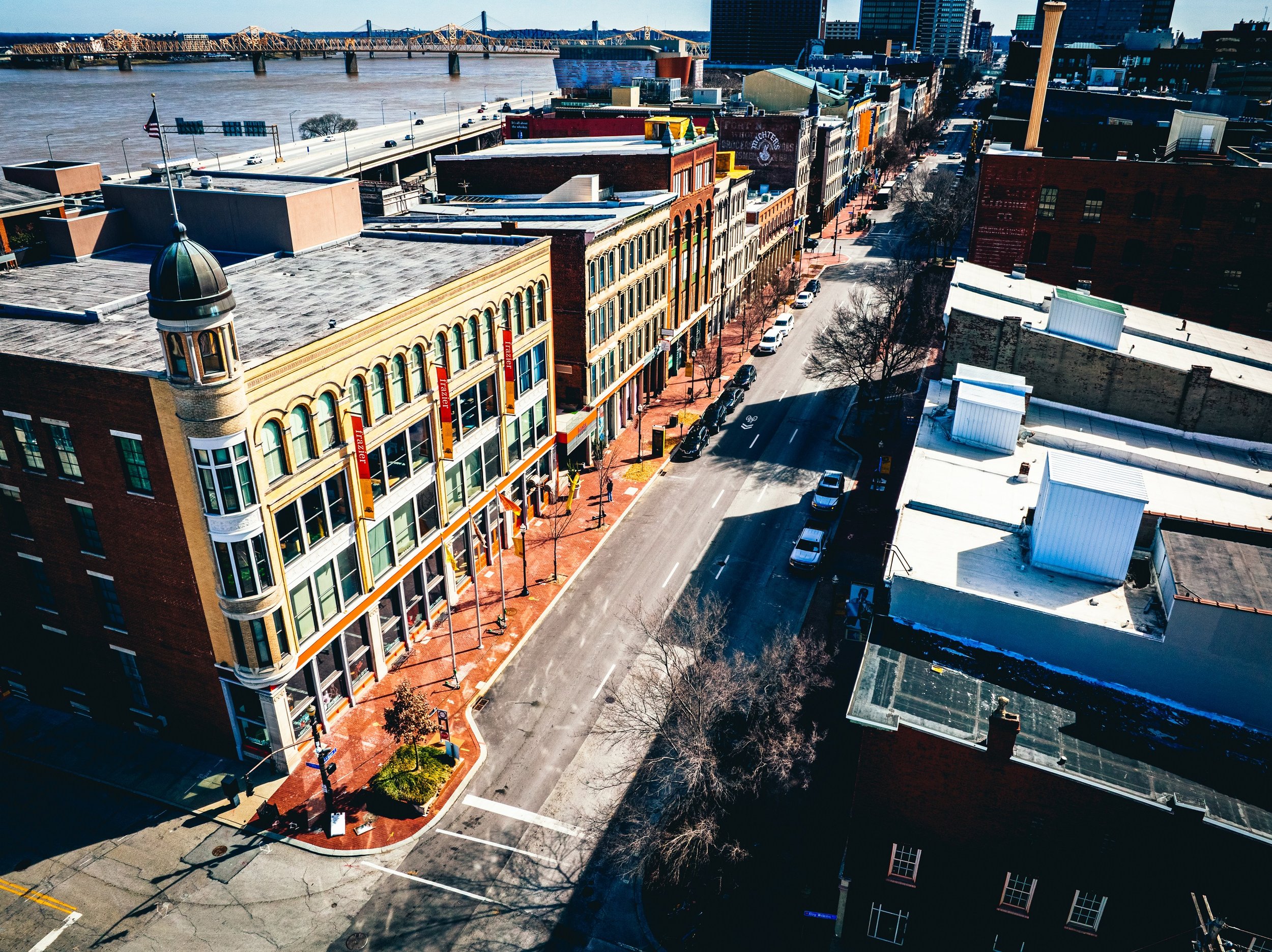
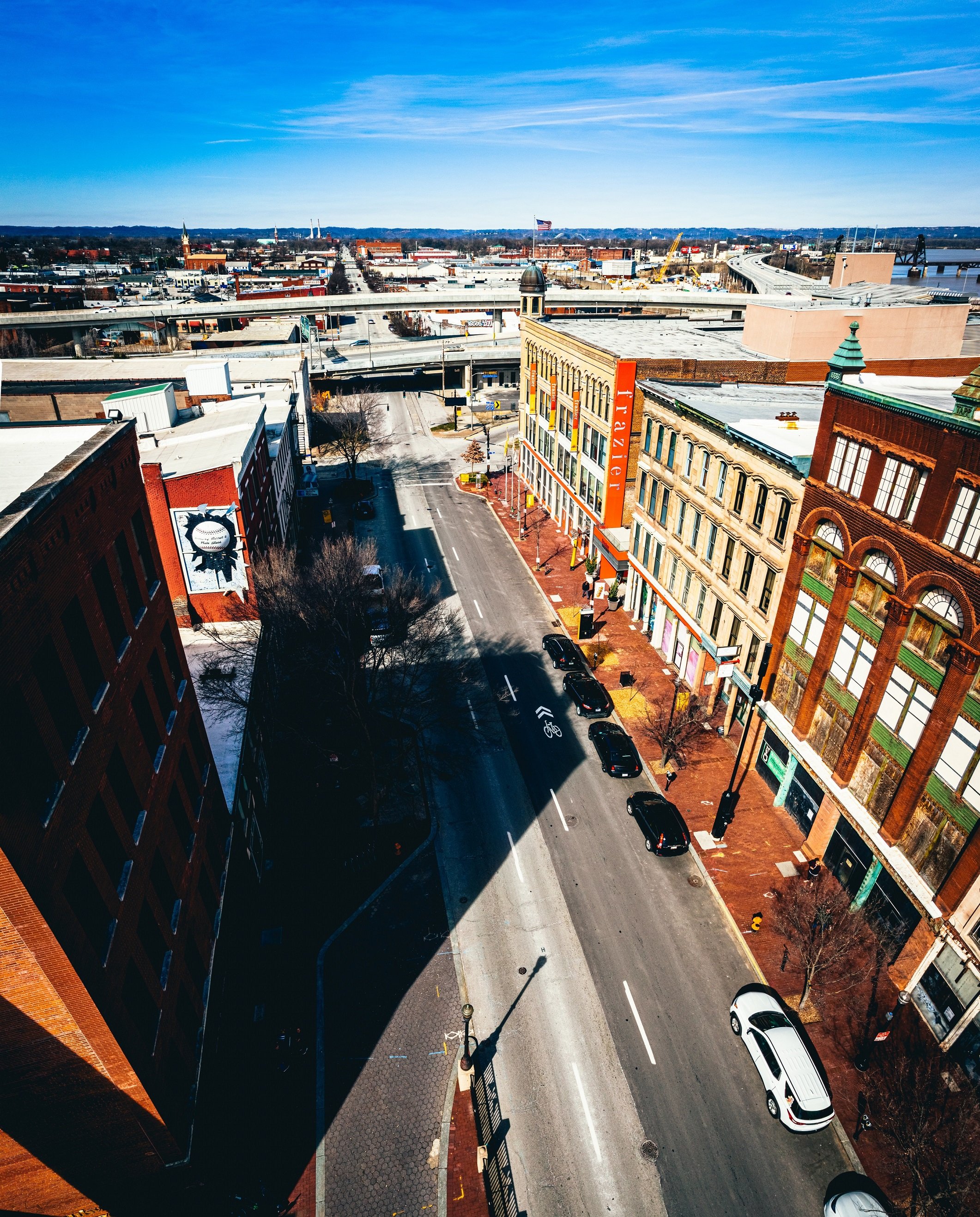
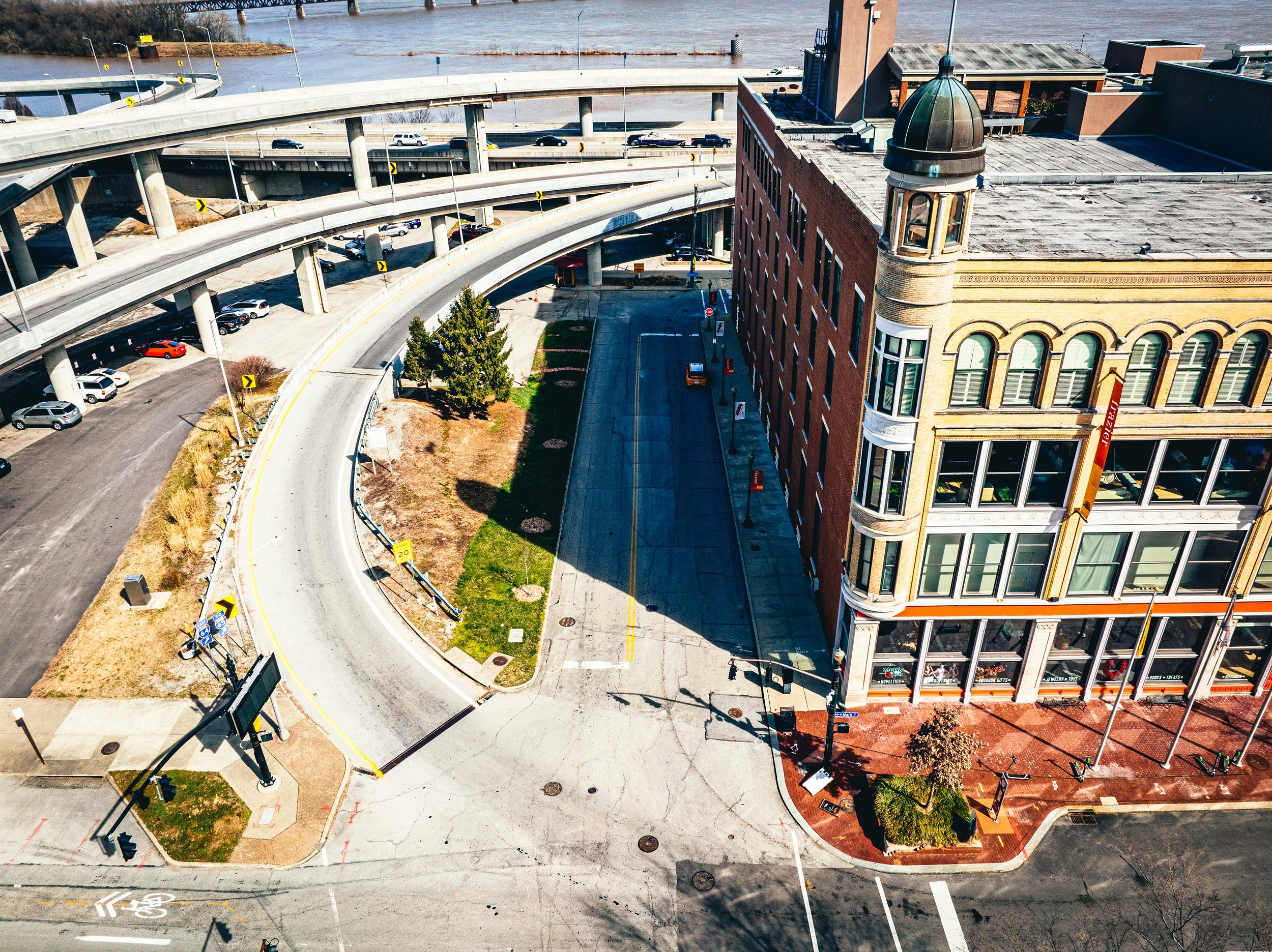
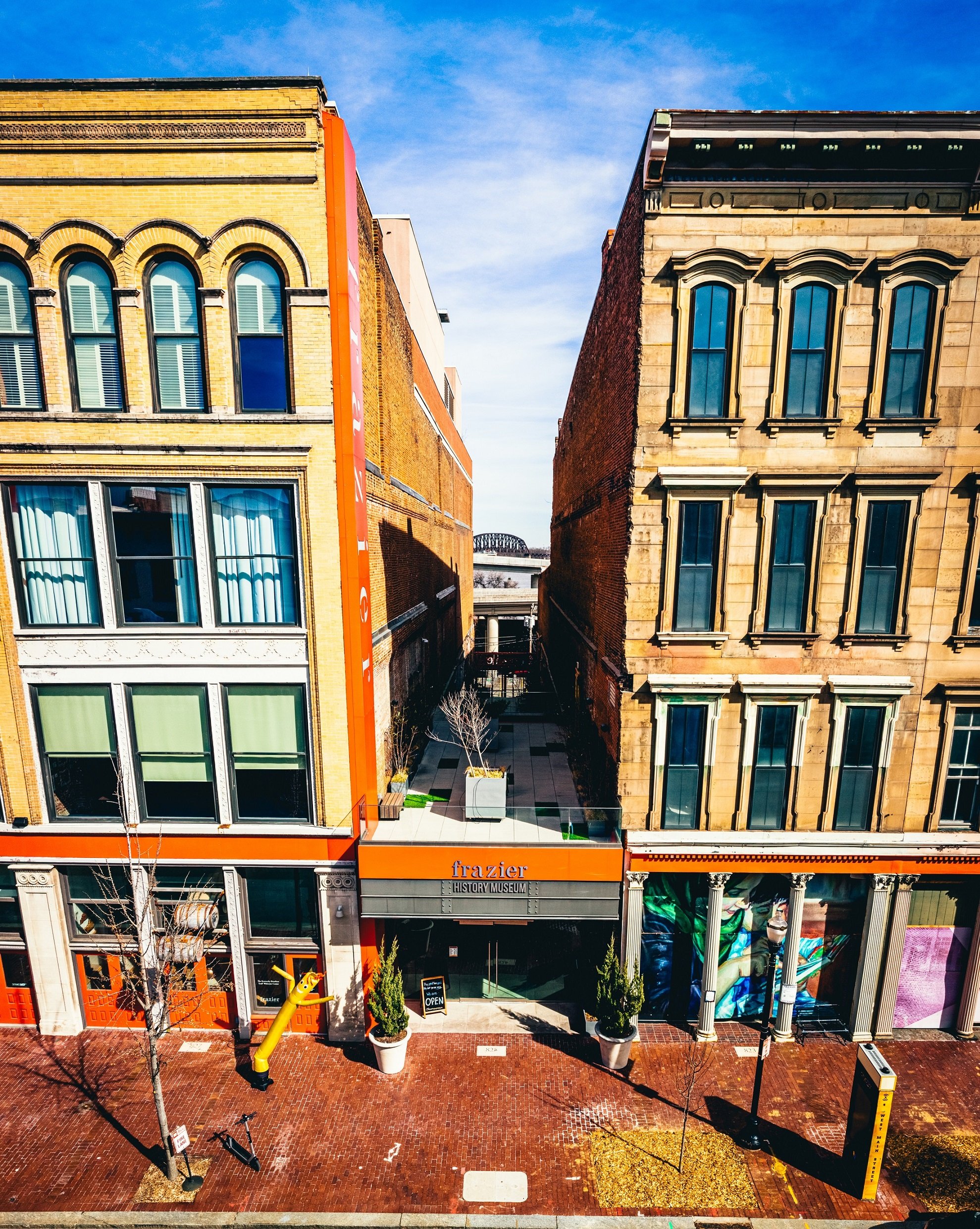
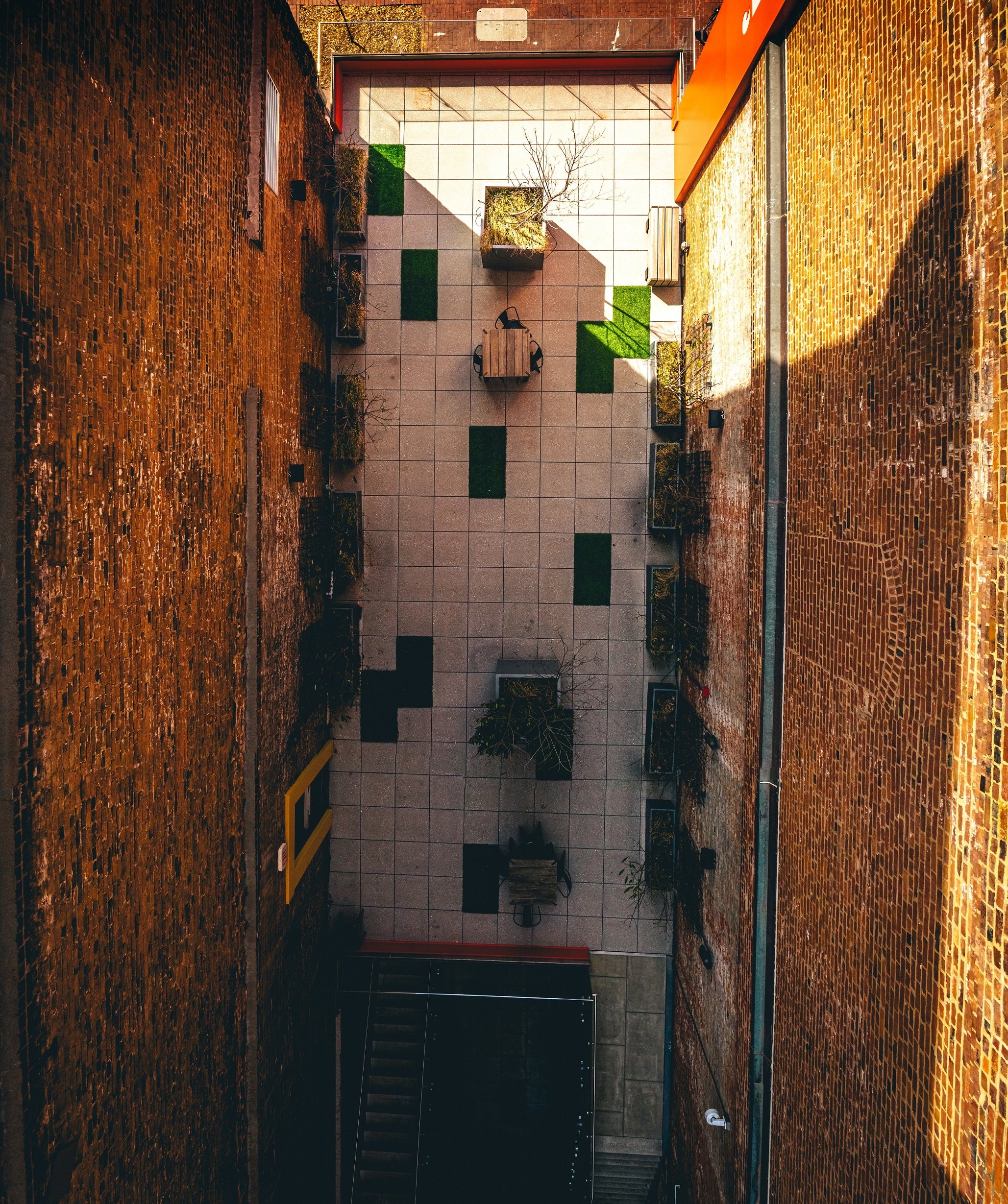

Pictured, from left: Facing east on Main Street from Ninth Street; facing west on Main Street from Eighth Street; facing north on Ninth Street from Main Street; facing north at the Frazier’s Gateway Garden from Main Street; overhead view of the second-story rooftop level of the Frazier’s Gateway Garden; and facing south at the Frazier’s Gateway Garden from Washington Street, March 14, 2022. Credit: Jesse Hurt.
The beer fest will take place on Main Street, between Eighth and Ninth, and on Ninth Street, between Main and Washington. Traffic will be rerouted due to road closures.
VIP Admission ticketholders will have access to the Frazier’s Gateway Garden, which is located on the east side of the Frazier’s building and extends from Main to Washington Streets. The Gateway Garden consists of a linear courtyard populated with native Kentucky plants and furnished with wooden furniture. A staircase at the south end of it leads to a second-story rooftop area with a balcony overlooking Main Street.
Proceeds from this event support the Frazier’s current and future exhibitions, including Cool Kentucky, West of Ninth, and The Commonwealth: Divided We Fall. But they also support our educational programs, including free or reduced admission for Title 1 students; our “Let’s Talk: Bridging the Divide” panel discussions, summer and winter camps, family days, live engagements, and guided tours.
Secure your tickets today!
Simon Meiners
Communications & Research Specialist
Kentucky Bourbon Distillery Spotlight: Limestone Branch Distillery
Graphic for Kentucky Bourbon Distillery Spotlight: Bardstown Bourbon Company. Credit: Frazier History Museum.
Stephen Beam, master distiller at Limestone Branch Distillery in Lebanon, Kentucky, hails from two renowned Kentucky distilling families: the Beams and the Dants. His great-great-grandfather was early Bourbon pioneer Joseph Washington Dant, and his great grandfather on the other side of his family was Minor Case Beam, eldest son of Joseph M. Beam of the legendary Beam family.
Overhead view of Limestone Branch Distillery property in Lebanon, Kentucky, undated. Credit: Allie Filley.
After enjoying a successful career as a landscape architect, Stephen put his career on hold in the early 2000s to pursue his dream of carrying on his family’s distilling tradition. Stephen immersed himself in distilling, becoming a student of the craft. He took classes at the University of California-Davis and the American Distilling Institute, attended seminars at Kothe Stills and Koval Distillery, and completed an apprenticeship at Copper Run Distillery in Branson, Missouri. His friends and family members also provided a wealth of knowledge.
Since opening Limestone Branch Distillery in 2012, Stephen has worked tirelessly to revive the brands his family made famous. One such pursuit has been Steve’s efforts to revive his family’s original Yellowstone Bourbon recipe.
Limestone Branch Distillery master distiller Stephen Beam, undated. Credit: Allie Filley.
Even before opening Limestone Branch Distillery, Stephen drew inspiration from a recipe found in notes from his grandfather, Guy Beam. So he set about rekindling cloned yeast using DNA from a yeast jug belonging to his great-grandfather, Minor Case Beam, and the seeds for what would become Yellowstone Family Recipe were sown.
Bottle of Yellowstone Bourbon Family Recipe, undated. Credit: David Cole.
Since 2015, Limestone Branch Distillery has been producing this recipe, which reflects the original Yellowstone Bourbon mash bill. The product is made using traditional distilling methods, barrel-aged for six years, and bottled at 100 proof (50% ABV).
The distillery recently produced enough Bourbon to introduce Yellowstone Family Recipe, a limited-release, craft-distilled, annually offered spirit honoring 150 years of Beam- and Dant-family distilling tradition.
Starting in April 2022, the first of only 6,000 cases of this year’s release of Yellowstone Family Recipe will be available at retail. At this time, one of the only places to find Yellowstone Family Recipe is Limestone Branch Distillery. That's just one of many reasons to visit Limestone Branch Distillery this spring!
Caitlin Jackson
Brand Manager, Limestone Branch Distillery
Guest Contributor
Bridging the Divide
With our exhibition “West of Ninth: Race, Reckoning, and Reconciliation,” we hope to shine a light on those who’ve broken barriers and fought for change. We also want to highlight the historic roots of Louisville’s Ninth Street divide, delving into issues of race, segregation, and redlining in the city. For Frazier Weekly, we’ve partnered with Cave Hill Cemetery to bring you stories of notable Kentuckians buried at Cave Hill who deserve our attention. This week, Alexandra Luken shares the story of Julius Calloway Jr., a Tuskegee Airman who hailed from Louisville. As we count down to Thunder Over Louisville, April 23, when we look to the skies for planes and fireworks, we’ll also be celebrating the seventy-fifth anniversary of the United States Air Force. The Tuskegee Airmen, the first Black military aviators in the US Army Air Corps, were a precursor to the US Air Force. Here’s a short story on their history and contributions.—Rachel Platt, Director of Community Engagement
The Tuskegee Airmen were the first ever African Americans to be trained as pilots for the United States Army Air Corps. The military services were strictly segregated and opportunities for Black people in the military were few. Black airmen flew in one-man fighter planes instead of multi-engine bombers because military authorities thought a flight crew would not take commands from a Black flight leader. Their prowess flying the legendary P-51 Mustangs on bomber escort missions led to the reputation that they never lost a bomber they were escorting to enemy fire—a unique accomplishment in World War II where some fighter escort groups lost as many as thirty-four percent of the bombers they were escorting.
Training for Black pilots came about through public pressure from the Black press, the NAACP, Senator Harry S. Truman, and Eleanor Roosevelt. The airfields at the Tuskegee Institute in Alabama became the training ground for 994 young men accepted into the program, which included college preparatory classes in algebra, physics, and trigonometry. Pilots in the program showed remarkable aptitude as pilots, with ninety-six being the lowest score among all their flight tests—there were no “wash outs.” However, trained Black pilots were excluded from flying in combat until after Eleanor Roosevelt visited the Tuskegee Institute and flew as a passenger with a Tuskegee-trained pilot.
US Air Force Major Julius Calloway Jr. climbs out of a P-40, 1944. Credit: Calloway family.
Born March 3, 1924, Julius Warren Calloway Jr.—the son of a World War I veteran and postman, Julius W. Calloway Sr., and Nathalee (Whitlock) Calloway—was raised in Louisville, Kentucky. Upon graduating from Central High School in 1942, he volunteered for the Army pilot training program. After completing basic training in Biloxi, Mississippi, he was sent to Tuskegee Institute as a cadet trainee. He received his wings as a single-engine pilot in November 1944 and trained as a replacement for the 332nd Fighter Group, but the war ended before he deployed. Julius W. Calloway was part of the 477th Composite Group which trained at Godman Army Field at Ft. Knox, Kentucky. The 477th was slated to be sent to Japan.
Following his discharge from the Army in 1946, Calloway joined the Air Force Reserves, where he continued to fly military aircraft. Following WWII, airline company hiring policies excluded hiring Black veterans as commercial pilots. Calloway established Calloway Flying Service at Bowman Field in Louisville, where he trained Black veterans as pilots under the GI bill. In 1953, he volunteered for active duty in the Korean War and trained pilots on jet aircraft—T-33s, F-8s, F-105s, and F-111s. He served overseas in Korea, Morocco, and Thailand before retiring as an Air Force major in 1970.
In 1997, Calloway was inducted into the Kentucky Aviation Hall of Fame. He was awarded an honorary doctor of public service degree from Tuskegee University in 2006, and the Congressional Gold Medal, which honors individuals whose achievements have an impact on American history and culture, in 2007.
Calloway died January 23, 2012. He is interred in Lakeview Mausoleum, Lot 2, Part 23, Range D, at Cave Hill Cemetery in Louisville.
Alexandra Luken
Executive Assistant, Cave Hill Heritage Foundation
Guest Contributor
History All Around Us
Rosie the Riveter Art Installation in Clarksville to be Unveiled
Most of you are probably familiar with Rosie the Riveter—the patriotic, World War II–era working woman who famously sports her iconic red bandana, all while exclaiming the phrase, “We can do it!”
But, did you know Kentucky once had its own Rosie the Riveter?
Rose Will Monroe wall panel in the Frazier History Museum’s Cool Kentucky exhibition, April 7, 2022. Credit: Shelby Durbin.
Rose Will Monroe was born in 1920 and grew up in Science Hill, a town in Pulaski County, Kentucky, as one of nine children. She lived in Kentucky until the age of twenty-two, when, shortly after her husband passed away in an accident, she moved. With two young children in tow, she moved to Ypisilanti, Michigan, where she took a job at Willow Run Aircraft Factory. Her job at the factory was to rivet B24 bombers.
During one of her shifts, actor Walter Pidgeon visited her workplace to film a promotional piece about war bonds. Following the success of J. Howard Miller’s poster of women in the workforce and Kay Kyser’s song “Rosie the Riveter,” producers got the idea to cast Rose the Riveter as Rosie the Riveter in the film.
Following her one and only acting job, Rose Will Monroe married Calvin Will and moved to Clarksville, Indiana. She went on to excel in many disciplines: For example, she opened her own construction company, became a beautician, and even got her pilot’s license!
Rosie the Riveter was—and still is!—an iconic cultural figure in US history. Working women ads of the WWII era were created to entice women to join the workforce in support of the war effort. This was a major shift for women at the time, many of whom had never taken a job outside of the home. Many of these first time workers were middle-class women, considering that lower income women had been working both inside and outside of the home for years. These ads were incredibly successful, as around six million women joined the workforce for the first time.
Plans for the new Rosie the Riveter art installation in Clarksville, Indiana, 2022. Credit: Clarksville Historic Preservation Commission.
In honor of Rose Will Monroe, the Clarksville Historic Preservation Commission launched a fundraising campaign to build an art installation in Ashland Park in Clarksville, Indiana, overlooking the Ohio River. Since they launched the campaign in early March, they have nearly doubled their initial goal of $40,000 by raising a little under $80,000 for the project! If you’d like to learn more about the project, visit the commission’s fundraising web page.
Selection of Rosie the Riveter merchandise sold in the Frazier's museum store, April 7, 2022. Credit: Shelby Durbin.
Be sure to visit the Frazier History Museum’s Cool Kentucky exhibition to learn about more fascinating figures from the Bluegrass State! (Also, don’t miss the museum store: We have quite the collection of Rosie the Riveter merchandise!)
Shelby Durbin
Education & Engagement Specialist
Membership
Announcing New Member-exclusive Summer Book Club
Help us shape what this new member-exclusive program will look like!
Our Summer Book Club will occur May through August. ALL members are welcome to participate in this program. Please take our survey to give us an idea of what excites you and what you look forward to.
Graphic for membership. Credit: Frazier History Museum.
Stay tuned! In next week’s edition of Frazier Weekly, we will be announcing the first book selection for our inaugural Summer Book Club meeting next month. RSVP information and further details will be shared at that time.
Want to join our book club but you’re not a Frazier member? Become a member today! As little as $20 will allow you access to our Summer Book Club and other member-exclusive events throughout the year!* Did I mention that for the $20 Individual membership you would also get year-round access to the museum, a ten percent discount in the museum store**, and discounted parking!?
*Not all member-exclusive invitations apply to the Individual and Family membership levels.
**Exclusions apply.
Come experience more!
Amanda Egan
Membership & Database Administrator










